Dental Implants in Austin
Overview
A dental implant is an artificial tooth root typically made of titanium, used to replace one or more missing teeth. Restoring missing teeth with dental implants involves coordinated planning between Dr. Ciaverelli and a surgical specialist, either an oral surgeon or periodontist. Determining whether dental implants are the right choice for a patient starts with a discussion of options at our office to go over the risks and benefits of the procedure, determine if any other procedures must be addressed first (ex. cavities or orthodontic issues), and determine the best location for the implant. The surgeon evaluates the quantity and quality of the patient’s bone and their overall health to verify they can receive an implant. After planning in concert with Dr. Ciaverelli, the surgeon then positions the implant into the jaw where over time, its titanium surface integrates with the bone. The implant then may be used as a stable foundation for Dr. Ciaverelli and his lab to build a crown, the visible portion of your tooth.
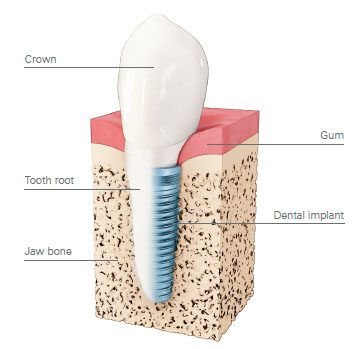
Click on the following animated video illustrating a dental implant used to replace a single missing tooth.
Overview

A dental implant is an artificial tooth root typically made of titanium, used to replace one or more missing teeth. Restoring missing teeth with dental implants involves coordinated planning between Dr. Ciaverelli and a surgical specialist, either an oral surgeon or periodontist. Determining whether dental implants are the right choice for a patient starts with a discussion of options at our office to go over the risks and benefits of the procedure, determine if any other procedures must be addressed first (ex. cavities or orthodontic issues), and determine the best location for the implant. The surgeon evaluates the quantity and quality of the patient’s bone and their overall health to verify they can receive an implant. After planning in concert with Dr. Ciaverelli, the surgeon then positions the implant into the jaw where over time, its titanium surface integrates with the bone. The implant then may be used as a stable foundation for Dr. Ciaverelli and his lab to build a crown, the visible portion of your tooth.
Click on the following animated video illustrating a dental implant used to replace a single missing tooth.
Why Choose single dental implants?
While exploring implants as a solution to their missing teeth, a patient may find an alternate treatment such as a bridge or removable partial denture better meets their immediate budget. However, due to their stability and longevity, a dental implant typically provides a better value in the long run. Creating a bridge involves placing abutment crowns on multiple teeth for the bridge to work. Hygiene becomes more difficult because they need to be cleaned under with special floss threaders. Because they are harder to clean, they leave teeth more susceptible to decay, and studies have shown they are much less likely to survive the long term versus implants. This may mean the loss of more teeth and the need for multiple implants in the future.

A removable partial denture is one of the oldest and the least expensive options to replace a single tooth. They are typically use metal or acrylic clasps to grip a fake tooth to the surrounding teeth. As the name states, it is removable. This allows for the cleaning of surrounding teeth, but it also means that it is not as stable as a bridge or an implant. It typically shifts while eating, and patients routinely complain that food is caught under them. Because of this and that they are bulky devices, they feel the least natural of the restorative methods. The partial dentures themselves have to be cleaned daily and tartar deposits must be removed from them. And unlike implants, they do not preserve bone.

A dental implant keeps a one tooth problem a one tooth problem. They preserve bone, cannot decay, the surrounding teeth are left alone and you can clean around them just like your old tooth, so they feel very natural. Patients give us the most positive feedback after restoring their missing teeth with an implant, voluntarily telling us how happy they are with their investment. Regardless of the restorative option one chooses, it is important to choose an option. Without a tooth to stimulate it, bone deteriorates. The forces on the surrounding teeth cause them to collapse into the missing tooth’s space. Teeth opposing the space tend to grow into the gap. This effects one’s bite and chewing efficiency, and complicates restoring the space.
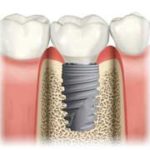
Click on the following video illustrating the options to restore missing teeth and the movement of teeth when a space is not restored.
What if i'm missing several teeth?
Dental implants still provide the best value over the long run. A few missing teeth can be replaced with individual implants next to each other allowing for easy hygiene. Alternatively, to save money a bridge can be secured to two implants. Because these bridges are placed on implants, they are not able to decay like tooth-borne bridges. However maintaining proper hygiene is still necessary to prevent gum and bone inflammation (not to mention fresh breath!).

Bridges become a less sensible option in this situation. The longer span of the bridge puts even more pressure on the teeth they are attached to, requiring additional teeth be crowned to keep it stable. This creates an even less hygienic situation, leaving the teeth more vulnerable to decay and bone loss (the following x-ray illustrates this), which increases the bridge’s potential failure and the likelihood for more expense and time in the dental chair.
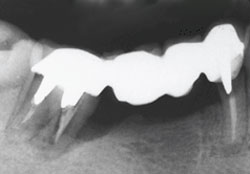
Again, a removable partial denture is the least expensive options in this situation, but not necessarily the best value. With larger spaces and fewer teeth to attach to, they become even bulkier, less stable, and more likely to retain food and debris below them. Eating food with the denture becomes more difficult. Patients complain of them moving and that they cannot chew fibrous foods like lettuce and other vegetables, so maintaining proper nutrition can become a struggle as well.
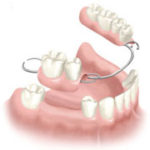
Tooth Replacement Scorecard
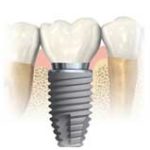
Dental Implant

bridge

partial denture
What if i'm missing ALL of my teeth?
Before dental implants gained clinical acceptance, the only option available to those who had lost all of their teeth was complete dentures. George Washington had dentures. Implants have revolutionized 18th century technology into the 21st century. Complete dentures are typically made of acrylics that imitate the gums and teeth. Dentures rest solely on the tissue, which can create sore spots, cover taste buds, add bulk that is uncomfortable, and make eating less enjoyable. Without teeth to rest upon, complete dentures (especially the lower denture) can move around while eating or talking. Patients tend to limit their diets to softer less fibrous foods creating a diet that lends itself to foods higher in sugars and carbohydrates. Also, dentures place pressure on the bone and gum tissue which leads to ongoing bone loss which worsens over time. The lower jaw is particularly vulnerable to this bone loss, further challenging the fit of the denture overtime, requiring multiple adjustments and revisions to prevent sore spots and accommodate the changes in bone.
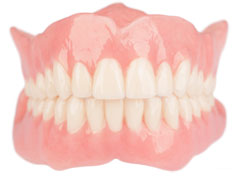
Utilizing dental implants to retain a complete denture is an excellent option to make it more functional and increase one’s confidence. There are a variety of options to do this, but adding just two implants to the mandibular denture is one of the the most popular and cost effective methods to gain more stability of the lower denture. By adding more implants you can improve stability and retention much like a four legged stool is more stable than balancing on just two legs. After the implants are secure to the bone, attachments called locator abutments are assembled between the denture and implants. These allow the denture to snap on to the implants. This still allows the patient to remove their dentures for easy cleaning, but helps eliminate the discomfort of them pressing on the tissues and embarrassment of the denture moving around while eating, talking, skydiving or laughing.
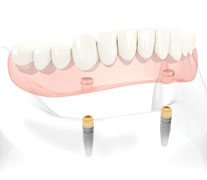
If patients are not enamored by either of these options and wish to abandon the concept of having a denture that comes in and out of their mouth, dental implants may also be used to retain a fixed prosthesis, one that is not removed by the patient and is bolted down and can only be removed by a dentist. In this scenario, four or more implants are placed in either arch, and prostheses are secured to them. Unlike dentures that rest on the gum tissue, a small amount of space is kept below the fixed prostheses to allow for better hygiene. A dentist is able to remove them if needed for repairs or more thorough cleanings.

Each patient brings with them unique variables that must be taken into account before they can determine the treatment that best meets their needs. To this end, Dr. Ciaverelli and Dr. Farnie recommend patients begin with a comprehensive evaluation and consultation before deciding what option is appropriate for them. Although multiple long-term studies show dental implants have very high success rates up to 98% for the mandible and 94% for the maxilla (be aware that multiple factors such as medical conditions, hygiene, smoking and bone quality all play a significant role in success). At the end of the day, implants are man-made and thus not completely precluded from failure for some. They may have issues integrating with the bone. The screw securing restorative parts to an implant can loosen and implant prostheses can chip or break like any crown. In case this happens, whenever possible we design our restorations in a way that allow them to be serviced. Patients should know that dental implants are more resistant to periodontal disease (bone loss) than teeth. However, keeping up with hygiene, both at home and with in-office cleanings, is still essential to prevent it from occurring. Please note that this information is for reference only and may not fully describe the risks and benefits of treatments specific to you. A good summary of implant risks can be found here.
Brodie Oaks General Dentistry
4422 Pack Saddle PAss
Suite 201
Austin, TX 78745
Get Directions
Monday 8am – 5pm
Tuesday 7:30am – 4pm
Wednesday 8am – 5pm
Thursday 7:30am – 4pm
Friday 7:30am – 12:30pm*
P: (512)445-5866
F: (512)445-4262
[email protected]
*We are open select Fridays.
Contact us for more information.